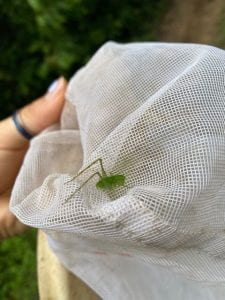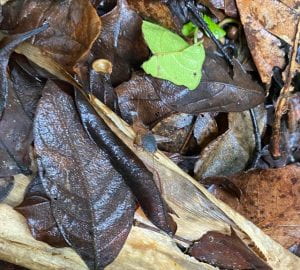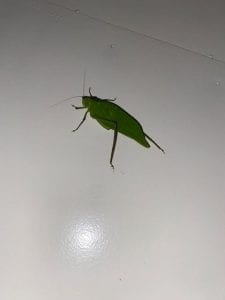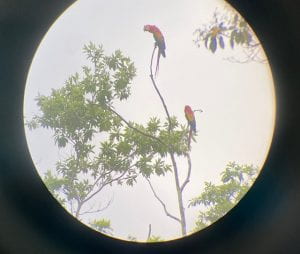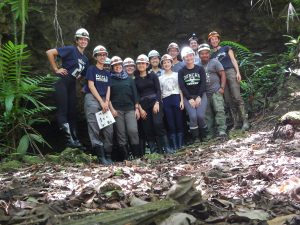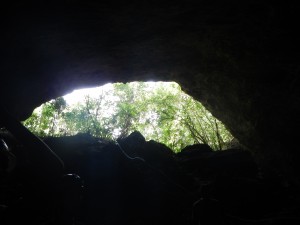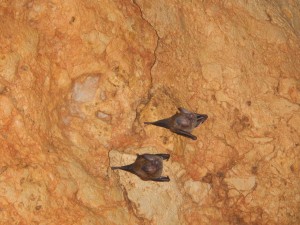May 20, 2025
Hello again! As you can tell from the title, today was yet another amazing day at Las Cuevas Research Station. The day began with some light birdwatching, during which we saw some flying macaws, a toucan, and a Northern Mealy Amazon parrot. These were very cool to see!
Our morning and half of the afternoon was filled with finishing up the Cecropia experiment and listening to presentations. Before I get into what we did with the second part of the afternoon, I’ll illustrate the results of our experiment. As you can see from the poster below, the question “was how do young cecropia trees defend themselves if they’re not colonized and protected by a colony of Azteca ants?” Unfortunately, our results were inconclusive. Due to limitations on time, we weren’t able to catch Orthoptera herbivores of the same species, so that factor was not standard, and we also had the problem of hydration of the leaves (we can’t know if the leaves were absorbing water, or how much they had at the time oof weighing, because we are in a field station with only one afternoon and one morning to devote to this project.) So, the results were inconclusive, but you can read our poster pictured below. (The poster was a collaborative effort; if you know me, you know that’s not my handwriting.) After the project was over, we had a presentation from the Rafael Manzanero, director of the Friends for Conservation and Development, which is a really cool Belizean NGO that manages the LCRS, Chiquibul National Park and Forest Reserve, and they defend it. They have armed rangers, filling the role that the government plays in the US. It was very interesting to hear from him. After that, I gave my Ants Taxon Briefing, Lily gave hers on Epiphytes, and Dyllan talked about plant-insect interactions. During those presentation, we also heard from Yasmini Manzanero, the FCD’s Cultural Heritage and Karst Expert, and she briefed us on the cave system we are to explore tomorrow.
After those presentations, we had the ant-man Super Bowl: we excavated leafcutter ant nests to find their fungal garden. This was truly exciting. First, we approached the young colony (~1 year in age, 1 entrance) which is in the clearing right next to Jane’s (LCRS Manager) cabin. This is an optimal location for a Leafcutter colony because they like forest edges. The edges provide easy access to fresh vegetation for their fungus, while also providing the queen easy access to get into the ground quickly. We began our excavation by digging next to the colony, because fungal gardens (which is where the queen is) aren’t usually underneath the colony entrance, but they’re off to the side. Excavating this way minimizes damage to the colony’s structure and garden. This was so fun, because Dr. Solomon pulled out the entire fungal garden on a large kitchen spoon. With the whole garden came the queen, which was also awesome to see. She was so huge, because she has to store her sperm for up to 20-25 years and she also has to store her fungus when she leaves the colony she’s from, so she had a lot going on. It was super cool to see her.
Once we had thoroughly explored the young colony, we approached the mature colony. The mature colony was ~x years old and had many entrances. We selected this mature colony because it was raised, meaning the fungal gardens would be easier to access. This colony presented a problem though: the many hundreds and thousands of soldier ants that swarmed as we excavated. This meant that everyone had to put their things far away, and continually stomp soldier ants off their boots so they didn’t chew through them. As the ant-man, I was excited to see the horde of ants flowing out of the nest like a mighty stream and I grabbed the shovel. I was mostly successful, but I did get one battle wound. This was quite a different wound, as it hurt in the moment but it faded quickly. It also bled a lot, which was concerning (and turned my stomach bc I do not like blood very much) but that also subsided quickly. All in all, it was a great ant-super bowl and I’m super proud to have been a part of the excavating. After the wounds, we found the fungus. This fungus was interesting because a) there was much more of it, naturally, and b) It had a different texture than the fungus of the young colony. I’d be interested to compare them in a lab.
Following dinner, we had our first night hike. We saw a rare Pauroque bird (one of the “heard not seen” birds,) but the coolest thing we saw was the leafcutter ant highway. During the day, you see a couple or even a steady stream of ants flowing on these highways. At night, this highway was PACKED. It probably looked like the Katy Freeway when they brought 45, 90, and 180 to Rice. It is pictured below.
Images:
Cecropia Experiment Poster (if you have seen me write, you know that I did not write this. It was a collaborative effort.)
Battle wound from Excavation of Mature Colony (Got bit by Soldier Atta cephalotes)
Young Colony’s Fungal Garden
Ant Highway During Night Hike























